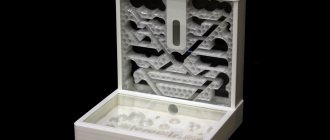History of studying the properties of water
The origins of ancient philosophy say that everything in nature is formed by four elements (elements): earth, air, fire and water. This idea lasted until the beginning of the Middle Ages.
In 1781, British physicist and chemist Henry Cavendish informed the scientific world that he had obtained water by burning hydrogen, but unfortunately he himself could not fully appreciate the importance of his discovery.
In 1783, the founder of modern chemistry, Antoine Laurent Lavoisier, was able to experimentally prove that water is not a chemical element, a compound of hydrogen and oxygen.
In 1819, the Swedish chemist Jons Jakob Berzelius and the French chemist Pierre Louis Dulong and a little later in 1842, the French chemist Jean Baptiste Dumas, together with the Belgian chemist Jean Servais Stas, were able to establish the weight composition of water by passing hydrogen through copper oxide.
Based on laboratory studies, scientists were able to determine the ratio of hydrogen to oxygen for water. In 1820, the French chemist Joseph Louis Gay-Lussac was able to measure the volumes of hydrogen and oxygen gases that, when combined, produced water. The derived ratio showed the expression 2 to 1, which corresponds to the modern formula of water -
Today we could say that humanity already knows everything about water, but how water appeared on planet Earth still remains unresolved. Some scientists say that water on Earth was formed due to the synthesis of hydrogen and oxygen. Soviet mathematician Otto Yulievich Schmidt believes that water was brought to our planet from outer space during the formation of the planet.
Along with cosmic dust and mineral particles, pieces and blocks of cosmic ice fell to Earth, which, when the planet warmed up, turned into water vapor and water.
The best way to purify water at home
Method 1. Boiling.
Every day we boil water to drink tea or coffee, cook food, or simply cool it and pour it into a jug to drink later. But is boiling such a good way to purify water?
You need to boil water for at least 10-15 minutes. Only in this case a significant part of the microorganisms dies. This method has its drawbacks. In the process of boiling tap water for a long time, additional chloroform is formed - a carcinogen that causes cancer. In addition, our water often contains salts of heavy metals. When boiling, water evaporates and the concentration of salts in it increases. They are deposited on the walls of the kettle in the form of scale and lime and then enter the human body.
I took some rainwater. This water was cloudy and had a foreign odor. I boiled some of the water for 15 minutes. Having compared the water from the two cans, I saw that it was no different. The boiled water remained the same cloudy, the smell did not disappear. Boiling did not clear the water of impurities, but simply killed some microorganisms.
Method 2. Defending
For this method, tap water should be poured into a vessel or glass jar with a capacity of 3-5 liters and kept this way for 24 hours. The water can then be used for cooking. But drinking this water raw is not recommended. Moreover, you need to use 3/4 of water, because various salts, bleach and other harmful substances settle to the bottom of the vessel. The last quarter of the settled water must be poured out.
Taking water from a lake located in my city, I left it for a day. During this time, the dirt settled to the bottom and the water became clearer. After this, you need to carefully, without shaking, pour some of the water into another container. This water is clearly not drinkable, because although some impurities have settled to the bottom, many microorganisms and impurities that have not settled remain in the water.
Method 3. Freezing.
The purpose of freezing water purification is to improve the quality of drinking water. Tap water is replete with hardness salts, which have a harmful effect on the human body, accelerating its aging. This method helps to get rid of harmful hardness salts and saturate the water with oxygen. It is also possible to remove salts by distillation, but this method does not make it possible to obtain water that is beneficial for the body: the resulting water is not saturated with oxygen.
I took regular tap water and placed it in the freezer. After waiting until the water around the edges froze, I drained the water from the middle into a separate glass and left the resulting ice to thaw. Having compared the water in two glasses, I saw that the frozen water was clearer than usual. Pure water has frozen, but it is not a fact that there are no impurities there.
Method 4. Filtration.
What is water filtration? This term refers to all cleaning methods in which aqueous solutions under varying pressure are passed through the porous structure of a filter substance, devices or materials capable of retaining suspended and dissolved particles of a certain structure and size.
I took a cotton swab with gauze and ran regular tap water through this structure. There was a residue of impurities left on the cotton wool. Next, I took the water and passed it through the filter. I repeated the procedure with the cotton wool and saw that the cotton wool remained clean. And this is an indicator that the water has been purified very well.
Conclusion
While working on the project, I looked at various ways to purify water at home. The hypothesis was confirmed; it is indeed possible to optimally purify water at home. But for a better effect, you need to use not just one method, but combine them. Thus, the likelihood that impurities or microorganisms will remain in the water will be less.
Internet resources were used to write this work.
If you liked the page, share it on social networks:
Properties of water
1. Dipole (The dipole of a water molecule is characterized by a dipole moment, i.e., a vector directed from a negative to a positive charge. It is equal to the product of the charges and the distance between them).
2. High surface tension (Surface tension causes capillary phenomena, collects water in droplets, creates a surface film and allows some insects to move along it. The high polarity of molecules determines the ability of water to dissolve substances with ionic or covalent polar bonds).
3. Solvent (Each molecule of the solute is surrounded by water molecules, and the positively charged parts of the molecule of the solute attract oxygen atoms, and the negatively charged ones attract hydrogen atoms. Since the water molecule is small in size, many water molecules can surround each molecule of the solute).
4. High viscosity (The dynamic viscosity of water is higher than that of comparable non-hydrogen-bonded liquids. Moreover, the dependence of viscosity on pressure is anomalous: viscosity decreases with pressure and reaches a minimum of about 60 MPa (this pressure is equivalent to 6 km of water).
5. Large heat capacity (This means that a significant increase in thermal energy causes only a relatively small increase in its temperature).
6. Electrical conductivity (The electrical conductivity of natural water depends mainly on the degree of mineralization and temperature).
7. Radioactivity (Water can carry radioactive substances in soluble and insoluble particles. The particles can include minerals in the water, or foreign objects accidentally introduced into the water).
Gaseous state of aggregation of water
A special feature of water is that its molecules are capable of changing the nature of their bonds with each other when temperature fluctuates. Its basic properties do not change. If you heat water, its molecules begin to move faster.
Those. molecules that come into contact with air break their bonds and mix with its molecules. Water in a gaseous state retains all its qualities, but also acquires the properties of a gas. Its particles are located at a great distance from each other and move intensively. Most often, this condition is called water vapor.
It is a colorless, transparent gas that, under certain conditions, will turn back into water. It is ubiquitous on Earth, but most often it is not visible. Examples of water in the gaseous state are clouds, fog, or water vapor produced when a liquid boils. In addition, it is found everywhere in the air. Scientists have noticed that when it is moistened, it becomes easier to breathe.
Most often, water turns into a gaseous state when the temperature changes. Ordinary steam, which is familiar to everyone, is formed during boiling. It is this whitish hot cloud that we call water vapor. When a liquid reaches its boiling point when heated, and at normal pressure this happens at 100°, its molecules begin to evaporate intensively. When they fall on colder objects, they condense into droplets of water.
If a large amount of liquid is heated, saturated steam is formed in the air. This is a state where gas and water coexist because the rate of evaporation and condensation is the same. When there is a lot of water vapor in the air, it is said to have high humidity. When the temperature drops, such air intensively condenses moisture in the form of droplets of dew or fog. But for fog to form there are few special conditions of temperature and humidity.
It is necessary that there be a certain number of dust particles in the air, around which moisture condenses. Therefore, in cities, fogs due to dust form more often.
The process of steam formation is called vaporization. Every woman observes it when cooking. But there is also a reverse process, when the gas turns back into water, settling on objects in the form of tiny droplets. This is called condensation. How does vaporization most often occur?
Under natural conditions, this process is called evaporation. Water evaporates constantly under the influence of solar heat or wind. The formation of steam can be artificially caused by boiling water.
This is the process by which the gaseous state of water is obtained. It can be natural or accelerated using various devices. Water is constantly evaporating.
People have long used this property to dry clothes, dishes, firewood or grain. Any wet object gradually dries due to the evaporation of moisture from its surface. In their movement, water molecules break off one after another and mix with air molecules.
Ways to improve water quality
There are various groups of methods for artificially improving water quality, regardless of the type of pollution and the nature of the impurities. Among them:
- Biological
- Physical
- Chemical
- Physico-chemical
To achieve maximum results, an integrated approach is most often used - combining the most effective methods and systems for water purification.
Biological methods. A similar method involves using various living organisms to remove harmful impurities from water. This direction is considered today the most promising, providing ample opportunities in the fight against a wide variety of pollutants contained in wastewater.
Most often, various types of bacteria capable of decomposing and processing chemical and physical pollutants are used as “living cleaners”. Sometimes algae and representatives of microscopic fungi are used for these purposes.
One of the advantages of using this cleaning method is the ability to select cleaning microorganisms depending on the nature and composition of the substances to be removed. As an example, we can consider nitrifying microorganisms.
In the process of their life activity, they decompose and neutralize nitrogen-containing chemical components. Other bacteria can consume phosphorus-containing components.
Reproducing in water bodies, accumulations of such beneficial organisms that filter water form entire colonies. Most often they are concentrated in the bottom layers, in the form of a dark brown or black mass.
Physical methods. Such methods are for the most part part of complex techniques, as a preliminary stage of filtration work. Physical methods can be used to treat large volumes of liquid waste.
Some modern methods of physically removing contaminants allow for deep cleaning, but their performance is not sufficient for working with large volumes of water. An example of fine physical purification is membrane filters that can trap even pathogenic microorganisms, molecules of heavy metals, salts and oxides.
All methods of physical water purification are divided into several types:
- Straining
- Advocacy
- Filtration
- Ultraviolet disinfection
Chemical methods. Chemical water purification is based on the interaction of reagents with various types of pollutants. As a result of a chemical reaction, harmful substances decompose into safe components or change their state - contaminants turn into insoluble compounds and precipitate.
Based on the type of chemical interaction, three main methods of chemical water purification can be distinguished:
- Neutralization
- Oxidation
- Recovery
Physico-chemical methods. Physico-chemical methods and methods of water purification are quite diverse and form a fairly large group. Exposure to pollutants and toxic substances is carried out using a combination of physical methods and chemical reagents. This allows you to better clean the liquid from dissolved gases and toxins, fine solid and liquid particles. This is an excellent way to purify water from manganese and other heavy metals.
The physico-chemical method can be used at any stage of removing harmful substances. It is equally well suited for preliminary normalization of liquid composition and for deep cleaning.
Key methods of water purification by physical and chemical means:
- Flotation
- Ion exchange
- Reverse osmosis
- Electrodialysis
- Extraction
- Sorption
How does the composition of water affect the human body?
Water is one of the basic elements of all living things. A person consumes water every day to meet his needs. It is precisely because of the constant consumption of water that its pollution poses a threat to human health. Polluted water causes a huge number of diseases, which leads to a reduction in human life expectancy.
All types of water pollution affect human health: biological, chemical, radioactive. Biological pollution includes human and animal waste products, as well as bacteria and viruses.
Chemical pollution is a change in the natural chemical properties of water due to an increase in the content of harmful impurities of inorganic (mineral salts, acids, alkalis, clay particles) and organic nature (oil and petroleum products, organic residues, pesticides). Radioactive contamination of water means its saturation with relevant substances and chemical elements that emit radiation.
Issues of cleanliness and safety of drinking water are discussed both among the population and at the legislative level. Water quality is regulated by all sorts of rules and regulations, indicating what kind of water is safe for humans in epidemiological and radiation terms, what its chemical composition, taste and smell should be.
Water purification methods
Boiling. As a result of this process, chlorine and hydrogen sulfide are easily removed from the water, most pathogenic microbes are killed, and calcium and magnesium salts are removed from the water. The water becomes softer, its structure changes. But boiling deteriorates the chemical composition of water, at the same time the concentration of dissolved substances increases, and harmful particles such as potassium, mercury, nitrates and pesticides are not removed.
Not all microorganisms die at 100 degrees. With prolonged boiling, the concentration of dissolved substances increases as the volume of liquid decreases. Prolonged boiling further aggravates the chemical situation. In addition, the water becomes tasteless. It is advisable to drink boiled water only when there is no other way to purify the water.
Advocacy. One of the ways to improve the quality of water is to settle it, but here we must remember that standing water for more than 12 hours is simply dangerous. The purpose of water sedimentation is to get rid of water-insoluble particles. Removal of dissolved chlorine during sludge is far from complete. When water settles for at least 3 hours, the concentration of free chlorine decreases, but heavy metal salts and other substances harmful to the body are practically not removed.
Filtration. Carbon filters used at home are designed to remove organic impurities and chlorine. Carbon filters are the most effective and economical for purifying water from various odors. Activated carbon is used as a filter. This filter material allows you to effectively purify water from chlorine and organochlorine compounds.
In addition, it significantly improves water properties such as taste, smell, color. Pollutants are only partially retained by the pores of the filter on its surface. Over time, the effectiveness of the filter element decreases and the quality of the resulting water deteriorates unpredictably.
Freezing. Since ancient times, melt water has been widely used in healing practice. It was not difficult to get it: they brought a full trough of snow or ice to the hut from the yard and waited for it to melt. Melt water helps remove waste and toxins from the body and gives it a strong energy boost.
Nowadays, it is not so easy to find snow that will turn into clean, healthy water after melting. Those who believe in the healing power of melt water use a trick by freezing the water at home in the freezer.
The most useful water is the one that thaws the fastest - it contains the least amount of impurities. The properties of melt water remain for 7–8 hours after defrosting the ice, but to obtain a noticeable healing effect, it is better to drink melt water immediately after defrosting.





